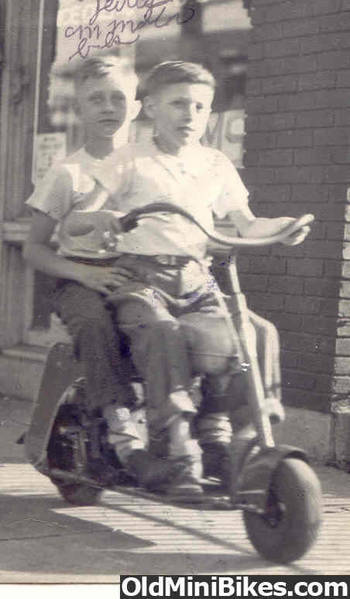Very nice! Now you need some black, round head standard slot screws to attach it to the frame with

My right hand guard (as I sit on the bike) has a 1" or so slot in it at the top just next to the where the main crossbar T's into the seat part of the frame. I believe this is for the brake cable and the cable goes under the bar, I think with the earlier one cable type the cable went through the bar, is there a hole there ?
Yes, there is a hole in the 1" tube for the brake cable to go through on this early model. The side panel has a vertical slot at that position so it can be removed without withdrawing the brake cable. This was shown on the side panel pattern [that I was sent] that was for the early style.
After working with the pieces I have come to the conclusion that the side panels and the fancy-smancy drive guard and design afterthoughts. It is clear to me that the frame/engine/drives/wheels design was worked out and then their eye fell to making it a true 'scooter' with a 'look' that was 'modern' and stylish. Take a look at the Salsburys and Moto Scoots and common Cushman and etc.. They all HAD to have body panels to be accepted as a 'scooter'. A full front fender was common before and after the war. Again, I believe the styling issues came last and were 'stick-on' items....except for that cute little front fender! The "hoof", only on the early model that sticks out the rear of the side panels, to me at least, denotes an attempt, a last minute attempt, to show a 'swoopy' appearance that denoted speed or motion. They got rid of that soon enough. I can but imagine droves of people asking why it was there and no one having an answer. I trust I'll incur the wrath of few if I opine that the body work, with the exception of that lovely and well proportioned front fender, is terribly amateuristic and quaint. And, in that opinion, I'm being kind; many would use really jestful words. The seat, again...this is just but one man's opinion, is the epitome of afterthought design. Lights, license plate mount, on-off switch, fuel tank and it's mounting all show a rush to market that can't be described, except by a very, very charitable person, as being well thought out.
I suppose today is a good day to do a trial fit of the engine and think about what I'm going to use as a drive system. This is where I must stray far from original. I do not have the correct engine...no kick starter. There are no original drive components or rear wheel and axle. All must be special made. There is absolutely no chance I will search around and pay big bucks for those parts. It's simply not going to happen. As the original drive system was of a crazy and complicated design it will not be replicated. The attached picture is what Yesterday's Rides sells as a modern version of the Doodle Bug. As I have some late model engines that are nice [5 HP Briggs] I still have it in my mine that it's an option. With the TAV it would be a nice runner. I can buy a TAV from OldMiniBikes for far less than an original clutch. As my machine is to be ridden on the street it does make sense. The second pic is of the owner loading the jig he made for perfectly replicating the frames.




